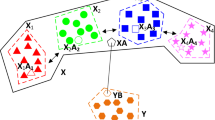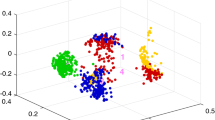Abstract
Set based image classification technology has been developed successfully in recent decades. Previous approaches dispose set based image classification by employing all the gallery sets to learn metrics or construct the model using a typical number of parameters. However, they are based on the assumption that the global structure is consistent with the local structure, which is rigid in real applications. Additionally, the participation of all gallery sets increases the influence of outliers. This paper conducts this task via sparse projection learning by employing ℓ2,1 norm from the perspective of the query set. Instead of involving all the image sets, this work devotes to searching for a local region, which is centered with a query set and constructed by the candidates selected from different classes in the gallery sets. By maximizing the inter-class while minimizing the intra-class of the candidates from the gallery sets from the query set, this work can learn a discriminate and sparse projection for image set feature extraction. In order to learn the projection, an alternative updating algorithm to solve the optimization problem is proposed and the convergence and complexity are analyzed. Finally, the distance is measured in the discriminate low-dimensional space using Euclidean distance between the central data point of the query set and the central one of images from the same class. The proposed approach learns the projection in the local set centered with the query set with ℓ2,1 norm, which contributes to more discriminative feature. Compared with the existing algorithms, the experiments on the challenging databases demonstrate that the proposed simple yet effective approach obtains the best classification accuracy with comparable time cost.





Similar content being viewed by others
Notes
In this paper, factitious set are the set constructed by devices and only indicates the image individuals are multi-view appearances of same subject. Conversely, inherent set can indicate the label information. If two sets are belonging to the same class, they are in the same inherent set.
References
Arandjelovic O, Shakhnarovich G, Fisher J, Cipolla R (2005) Face recognition with image sets using manifold density divergence. In: CVPR, pp 581–588
Cevikalp H, Triggs B (2010) Face recognition based on image sets. In: CVPR, pp 2567–2573
Chen L (2014) Dual linear regression based classification for face cluster recognition. In: CVPR, pp 2673–2680
Cheng G, Zhou PC, Han JW (2017) Duplex metric learning for image set classification. IEEE Trans Image Process 27(1):281–292
Crisp DJ, Burges CJC (1999) A geometric interpretation of v-svm classifiers. In: NIPS, pp 244–250
Du X, Wang JY (2015) Support image set machine: jointly learning representation and classifier for image set classification. Knowl-Based Syst 78:51–58
Hayat M, Bennamoun M, An SJ (2015) Deep learning non-linear reconstruction models for image set classification. IEEE Trans Pattern Anal Machine Intell 37(4):713–727
Hu YQ, Mian AS, Owens R (2011) Sparse approximated nearest points for image set classification. In: CVPR, pp 121–128
Huang ZW, Wang RP, Shan SG, Chen XL (2015) Projection metric learning on grassmann manifold with application to video based face recognition. In: CVPR, pp 140–149
Kim M (2018) Dynamic sparse coding for sparse time-series modeling via first-order smooth optimization. Appl Intell 48(11):3889–3901
Kim TK, Kittler J, Cipolla R (2007) Discriminative learning and recognition of image set classes using canonical correlations. IEEE Trans Pattern Anal Mach Intell 29(6):1005–1018
Lee KC, Ho J, Yang MH, Kriegman D (2003) Video-based face recognition using probabilistic appearance manifolds. In: CVPR, pp I–I
Liu B, Jing LP, Li J, Yu J, Gittens A, Mahoney MW (2019) Group collaborative representation for image set classification. Int J Comput Vis 127(2):181–206
Lu JW, Wang G, Moulin P (2013) Image set classification using holistic multiple order statistics features and localized multi-kernel metric learning. In: ICCV, pp 329–336
Mensink T, Verbeek J, Perronnin F, Csurka G (2013) Distance-based image classification: generalizing to new classes at near-zero cost. IEEE Trans Pattern Anal Machine Intell 35(11):2624–2637
Muja M, Lowe DG (2014) Scalable nearest neighbor algorithms for high dimensional data. IEEE Trans Pattern Anal Mach Intell 36(11):2227–2240
Nie FP, Huang H, Xiao C, Ding CHQ (2010) Efficient and robust feature selection via joint l21-norms minimization. In: NIPS, pp 1813–1821
Ren ZW, Sun QS, Yang C (2019) Nonnegative discriminative encoded nearest points for image set classification. Neural Computing and Applications. https://doi.org/10.1007/s00521-019-04419-y
Ross DA, Lim J, Lin RS, Yang MH (2008) Incremental learning for robust visual tracking. Int J Comput Vis 77:125–141
Shah SAA, Nadeem U, Bennamoun M, Sohel F, Togneri R (2017) Efficient image set classification using linear regression based image reconstruction. In: CVPRW, pp 601–610
Stallkamp J, Ekenel HK, Stiefelhagen R (2007) Video-based face recognition on real-world data. In: ICCV, pp 1–8
Tan HL, Gao Y, Ma ZM (2018) Regularized constraint subspace based method for image set classification. Pattern Recogn 76:434–448
Viola P, Jones MJ (2004) Robust real-time face detection. Int J Comput Vis 57(2):137–154
Wagner A, Wright J, Ganesh A, Zhou Z, Mobahi H, Ma Y (2012) Toward a practical face recognition system: robust alignment and illumination by sparse representation. IEEE Trans Pattern Anal Mach Intell 34(2):372–386
Wang RP, Chen XL (2009) Manifold discriminant analysis. In: CVPR, pp 429–436
Wang RP, Shan SG, Chen XL, Gao W (2008) Manifold-manifold distance with application to face recognition based on image set. In: CVPR, pp 1–8
Wang RP, Guo HM, DL S, D QH (2012) Covariance discriminative learning: a natural and efficient approach to image set classification. In: CVPR, pp 2496–2503
Wang W, Wang RP, Shan SG, Chen XL (2016) Prototype discriminative learning for face image set classification. In: ACCV, pp 344–360
Wang Y, Wang A, Ai Q, Sun HJ (2019) Ensemble based fuzzy weighted extreme learning machine for gene expression classification. Appl Intell 49(3):1161–1171
Wolf L, Hassner T, Maoz I (2011) Face recognition in unconstrained videos with matched background similarity. In: CVPR, pp 529–534
Yamaguchi O, Fukui K, Maeda K (1998) Face recognition using temporal image sequence. In: IEEE international conference on automatic face and gesture recognition, pp 318–323
Yan WZ, Sun HJ, Sun QS, Zheng ZC, Gao XZ, Zhang Q, Ren ZW (2019) Multiple kernel dimensionality reduction based on collaborative representation for set oriented image classification. Expert Systems with Applications 137:380– 391
Yan WZ, Sun QS, Sun HJ, Li YM, Ren ZW (2019) Multiple kernel dimensionality reduction based on linear regression virtual reconstruction for image set classification. Neurocomputing 361:256–269
Yang M, Zhu PF, Gool LV, Zhang L (2013) Face recognition based on regularized nearest points between image sets. In: IEEE international conference and workshops on automatic face and gesture recognition, pp 1–7
Zheng P, Zhao ZQ, Gao J, Wu XD (2018) A set-level joint sparse representation for image set classification. Inf Sci 448: 75–90
Zhu PF, Zhang L, Zuo WM, Zhang D (2013) From point to set: extend the learning of distance metrics. In: ICCV, pp 2664– 2671
Zhu PF, Zuo WM, Zhang L, Shiu CK (2014) Image set-based collaborative representation for face recognition. IEEE Trans Inform Forensics Secur 9(7):1120–1132
Zhu WJ, Yan YH (2018) Joint linear regression and nonnegative matrix factorization based on self-organized graph for image clustering and classification. IEEE Access 6:38820–38834
Zhu WJ, Yan YH, Peng YS (2016) Dictionary learning based on discriminative energy contribution for image classification. Knowl-Based Syst 113:116–124
Zhu WJ, Yan YH, Peng YS (2017) Pair of projections based on sparse consistence with applications to efficient face recognition. Signal Processing:Image Communication 55C:32–40
Acknowledgments
This work is in part by Natural Science Foundation of Zhejiang Province (NO. LQ20F030015).
Author information
Authors and Affiliations
Corresponding author
Ethics declarations
Conflict of interests
The authors declare that they have no conflicts of interest to this work.
Additional information
Publisher’s note
Springer Nature remains neutral with regard to jurisdictional claims in published maps and institutional affiliations.
Rights and permissions
About this article
Cite this article
Zhu, W., Peng, B., Wu, H. et al. Query set centered sparse projection learning for set based image classification. Appl Intell 50, 3400–3411 (2020). https://doi.org/10.1007/s10489-020-01730-3
Published:
Issue Date:
DOI: https://doi.org/10.1007/s10489-020-01730-3




